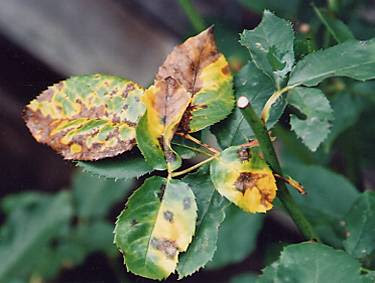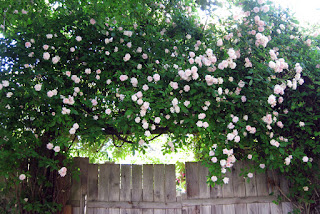BLACKSPOT
Otherwise known by the Latin name of Diplocarpon Rosae, blackspot is a prolific fungus that manifests itself as black spots on both sides of the leaves. The initial spots progress and become larger. The disease will spread through the whole leaf and turn it from green to yellow. The leaves will then drop off and eventually you will end up with a very bald rose that looks very sorry for itself.
The most important thing to do is to remove the dead yellow foliage immediately from the ground as the spores from the infected leaves will spread to the rest of the plant and you will experience the whole sad cycle again the following season. Collect the leaves and burn them. in regards to treatment this all depends on your own feelings towards pesticides. A Sulphur based solution is an extremely successful option and it has been used for many years by those who prefer a more chemical free approach to gardening. There are many brands of which you can take your pick and all are easy to purchase online or in your local garden centre. I personally prefer to use Rose Clear which is multipurpose as it fights not only blackspot but also mildew, rust and aphids. It is also chemical free which is important to me as I have two toddlers who constantly touch the roses.
The best way to manage this disease to to remove the effected areas as soon as Blackspots begin to appear and then sporadically spritz the plant and keep an eye on its progress over the following weeks.
MILDEW
This common fungal disease can be recognised by its white powdery presence on the plant. The impact of this fungus can be very disfiguring to the rose. Mildew or Podosphaera pannosa as it is otherwise known can be found on any part of the rose. It can cause a reduction in growth, buds may not open and leaves can become discoloured and shrivelled. Unfortunately last summer all of my Icebergs suffered from this so I'm hoping that this summer may see an improvement!
A Non-Chemical approach to dealing with mildew would be to again use a similar spray as mentioned before, Rose Clear, and to remove the affected areas. As well as this make sure that the plant is well watered during dry spells as a lack of moisture can also lead to an increase in the fungus. I also gave the rose a good hard prune to reduce spreading. Make sure you get rid of any cuttings or fallen debris as that will continue the cycle of infection. A good sprinkle of mulch will also help to get rid of it. My Icebergs are located in the middle of the border but on the other side of the fence in my neighbours garden there are four Leylanii which are responsible for sucking up all of the moisture out of the soil. Whilst some roses appear to tolerate this it appears that my Icebergs are not that sort. Subsequently I am out watering them after a dry day.
GREENFLY
These pesky bugs, also known as Aphids or plant lice, have been the cause of so much damage in my garden. So far this year there seems to be a lack of ladybirds which I wonder whether is all down to the poor weather that the UK has been having. The late frosts might have finished the poor things off.
Subsequently I have seen quite a lot of greenfly on my roses so far this year. Greenfly are one of the most destructive parasites which effect our plants. They were partly to blame for the Irish potato Famine as they are a disease carrying organism which transferred blight between potato crops. They are a sap sucking organism which is asexual in reproduction so they are extremely self-sufficient. There are many signs which you can look for in order to determine whether you have greenfly:
- Decreased growth rates
- Mottled leaves
- Yellowing
- Stunted growth
- Curled leaves
- Browning
- Wilting
- Low yields
- Death
Fortunately there are several things you can do to either prevent or cure. The main being insecticides. Not all of which have to be chemical if you are not fond of using them. I have a two year old and a three year old so using a chemical treatment is just not suitable. For regular garden infestations a spray such as Rose Clear will do the trick but this does not need to be applied everyday. You can simply use the high pressure setting on your hose to just to blast them off the leaves. I spent quite a bit of time doing this yesterday with my Buddjea as I noticed many of its leaves had curled.
RUST
Rose rust is a form of fungal parasitic disease which presents itself in the form of orange coloured nodules on the backs of the leaf. The orange rust will then change to tiny black pustules in late summer. After which the infected leaves will drop. The rust fungus sores are carried on the wind. Its Latin name is Phragmidium tuberculatum. It occurs normally in spring and will continue until the leaves drop. Whilst it is not as harmful or prevalent as blackspot or mildew, treating it promptly is recommended.
If you are not a fan of treating your roses chemically then pruning the infected area and removing all fallen leaves from the area should prevent further infection and keep it controlled. Rose Clear also helps to treat rust without any chemicals involved. The best time of year to treat a rose that has been infected with rust is in spring whilst the spores are dormant. A copper fungicide spread evenly over the leaves is successful method in ridding it from your plant.
Making sure that your roses are not too tightly bunched together and that any excess stems are removed will reduce the likelihood of your roses becoming infected. They like to have room for air to circulate around them. A good hard pure of any disease found will enable you to control the affected area.



















